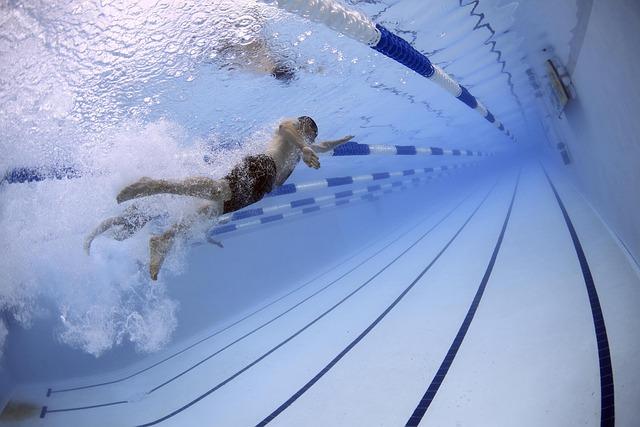In the serene embrace of water, where the world above fades into a gentle blur, swimming emerges as a silent symphony of movement and breath. It is within this aquatic ballet that the magic unfolds, transforming not just the body but the very essence of our internal rhythm. As each stroke cuts through the liquid expanse, swimming becomes more than a mere sport or pastime—it evolves into a powerful catalyst for enhancing lung capacity and cardiovascular performance. This article dives into the depths of how swimming, with its unique blend of resistance and fluidity, nurtures our respiratory and circulatory systems, offering a harmonious blend of physical endurance and serene tranquility. Join us as we explore the intricate dance between water and breath, uncovering the secrets that make swimming an unparalleled ally in the quest for optimal health and vitality.
Breath Control Techniques to Enhance Lung Function
Mastering the art of controlling your breath can significantly amplify your swimming performance, while also boosting your lung function. Diaphragmatic breathing is a fundamental technique to explore. By engaging the diaphragm, swimmers can maximize the amount of air inhaled, promoting more efficient oxygen exchange. This technique not only enhances endurance but also supports better buoyancy and balance in the water.
Incorporating interval breathing into your swim sessions can also yield substantial benefits. This involves varying the frequency of breaths taken during strokes, challenging your lungs to adapt to different oxygen demands. Consider these approaches:
- 3-5-7 breathing pattern: Breathe every third stroke on one lap, every fifth on the next, and every seventh on the final lap.
- Bilateral breathing: Alternate your breathing side every three strokes to promote balanced lung expansion.
These methods not only enhance lung capacity but also improve overall cardiovascular efficiency, making you a more powerful and resilient swimmer.

The Science Behind Swimming and Cardiovascular Health
Swimming stands out as a comprehensive workout that not only engages multiple muscle groups but also significantly boosts cardiovascular health. When you swim, your body is immersed in water, which offers natural resistance. This resistance forces your heart to pump more efficiently, strengthening the heart muscle and improving overall circulation. As a result, regular swimming sessions can lead to a lower resting heart rate and enhanced endurance.
- Increased Lung Capacity: Swimming requires rhythmic breathing, which trains the lungs to use oxygen more efficiently. Over time, this can increase your lung capacity, allowing for deeper and more controlled breathing.
- Enhanced Cardiovascular Function: The continuous motion of swimming boosts blood flow and oxygen distribution throughout the body, improving cardiovascular performance and stamina.
- Low-Impact Exercise: The buoyancy of water reduces the impact on joints, making swimming an excellent option for those with arthritis or joint pain, while still providing a heart-healthy workout.
Incorporating swimming into your fitness routine offers a unique combination of benefits, blending aerobic exercise with resistance training, all while enhancing cardiovascular health in a low-impact environment.
Incorporating Interval Training for Maximum Cardio Benefits
Interval training can be a game-changer for those looking to enhance their cardiovascular health through swimming. By alternating between high-intensity bursts and low-intensity recovery periods, swimmers can push their limits and achieve maximum benefits. This method not only boosts heart rate but also improves lung capacity over time.
- Enhanced Oxygen Utilization: Engaging in interval training helps the body to better utilize oxygen, making each breath more efficient.
- Increased Endurance: Regular intervals of high-intensity swimming increase stamina, allowing for longer swim sessions.
- Improved Heart Health: This type of training can strengthen the heart muscle, leading to better overall cardiovascular function.
Incorporating such sessions into your routine can make a noticeable difference. Whether you are a seasoned swimmer or a beginner, mixing intervals into your swim can add an exciting and beneficial challenge to your workouts.

Optimizing Your Swimming Routine for Improved Endurance
Enhancing your swimming routine to boost endurance involves a strategic approach that incorporates various elements. Interval training is a key component, which involves alternating between high-intensity bursts and periods of rest or low-intensity swimming. This method not only enhances cardiovascular performance but also increases lung capacity over time. By pushing your limits in short, controlled bursts, you teach your body to utilize oxygen more efficiently, thereby improving overall stamina.
- Incorporate breathing exercises: Focusing on breathing techniques during your swim can significantly enhance lung capacity.
- Vary your strokes: Different strokes engage different muscle groups and help maintain a balanced workout.
- Include dryland training: Strengthening core muscles outside the pool can improve endurance in the water.
Another effective strategy is to gradually increase the duration and intensity of your sessions. This progressive overload trains your cardiovascular system to handle longer distances and tougher challenges. To maintain motivation and track progress, consider setting specific, measurable goals, such as reducing lap times or increasing the number of laps completed without rest. By consistently pushing the boundaries of your comfort zone, you can elevate your endurance and enjoy the numerous health benefits that come with it.
Concluding Remarks
As we emerge from the depths of this exploration into the aquatic world, it becomes clear that swimming offers more than just a refreshing escape from the everyday. It is a symphony of breath and movement, a dance that harmonizes the body’s cardiovascular and respiratory systems. By diving into this timeless activity, we not only enhance our lung capacity and cardio performance but also embrace a form of exercise that fosters both mental clarity and physical resilience. Whether you’re gliding through the water like a seasoned athlete or just beginning to dip your toes into the pool, the benefits of swimming are as boundless as the ocean itself. So, next time you find yourself near water, remember that each stroke is a step toward a healthier, more balanced you. Dive in and let the waves of transformation carry you to new heights.
